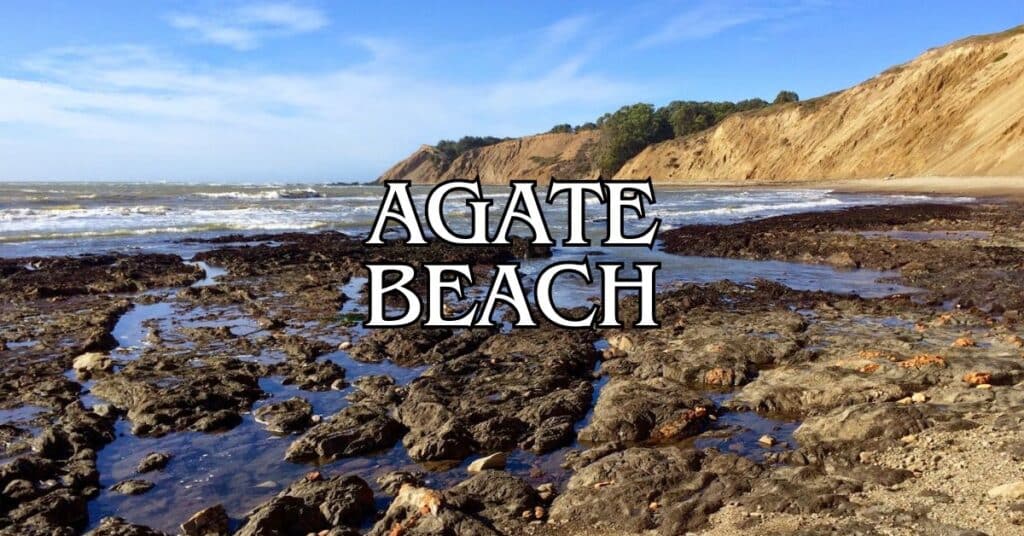Tucked away in Bolinas, Agate Beach feels like one of Marin County’s best-kept secrets. This compact 6.6-acre park opens up to nearly two miles of Pacific shoreline at low tide. It’s a prime spot for tide pooling along Duxbury Reef—just remember, you can’t collect rocks, shells, or marine critters.
If you’re planning a trip, timing really does matter. Low tide is when the place comes alive, with tide pools and more of the beach to explore. There’s a restroom near the parking lot and a pretty big parking area, which is great if you’re wrangling kids.
Discover hand-picked hotels and vacation homes tailored for every traveler. Skip booking fees and secure your dream stay today with real-time availability!
Browse Accommodations Now
You’ll find Agate Beach off Elm Road in Bolinas. Even though it’s a bit tucked away, it’s not too hard to locate. The landscape shifts from sandy stretches to shale reef and sandstone cliffs, so bring your camera if you’re into that sort of thing. It’s one of those rare Northern California beaches where you can actually find some peace and quiet—especially if you’re trying to avoid the crowds.
Overview of Agate Beach
Agate Beach is a peaceful little coastal park that gives you almost two miles of Pacific shoreline to wander. It’s a spot where you get natural beauty, cool geology, and a sense of seclusion that’s hard to come by in Marin.
Location and Setting
Agate Beach hugs the Pacific near the quirky town of Bolinas. The beach’s name comes from the colorful agate stones you’ll sometimes spot among the pebbles. It borders the southern end of Bolinas and connects to the wide Duxbury Reef.
This stretch of Northern California coast is a quieter alternative if you’re tired of the Bay Area’s busier beaches. Dramatic bluffs, broad sandy patches, and rocky tide pools set the scene—especially when the tide’s out.
Somehow, Agate Beach stays pretty mellow even in summer. You can actually stretch out, breathe, and enjoy the scenery without feeling like you’re elbow-to-elbow with strangers.
History and Geology
The beach’s agates formed millions of years ago, thanks to volcanic activity and all sorts of unique coastal geology. Agate Beach is tied to Duxbury Reef—the largest shale reef in North America—which juts out from Duxbury Point at the beach’s southern end. Waves have been shaping these rocks for ages, carving out the wild formations you see now.
Coast Miwok tribes once gathered food and resources here, long before European settlers showed up and founded Bolinas in the 1800s. Despite all that history, the beach area itself has stayed pretty much untouched compared to other parts of Marin.
Best Time to Visit
Late spring through early fall (so, May to October) is probably your best bet for decent weather. You’ll likely run into some of that classic summer fog, but it usually burns off by midday.
If you’re coming for tide pools, aim for low tide. Tide tables are your friend—check them before you leave. Mornings usually have the best light and the best tidepooling.
Weekdays are quieter. On weekends, expect more Bay Area folks making the trek. Winter can be wild, with storms rolling in—great for storm watching, but bring layers and expect rain from November through March.
How to Get to Agate Beach
Getting to Agate Beach means a scenic drive through Marin, and you’ll want to pay attention to a few details along the way. The route is beautiful, but it’s not exactly straightforward.
Directions from San Francisco
From SF, hop on Highway 101 North and cross the Golden Gate Bridge. Take the Highway 1/Stinson Beach exit and follow the signs. You’ll wind through Mill Valley, then climb up into Mount Tamalpais State Park.
Stay on Highway 1 as it hugs the coast. After Stinson Beach, keep an eye out for the (often missing) turnoff to Bolinas—locals love to mess with the sign, so don’t blink. It’s about 3.5 miles north of Stinson.
Once you’re in Bolinas, take Olema-Bolinas Road to Brighton Avenue, then hang a left on Elm Road. Follow it until you hit the Agate Beach parking lot.
Plan on about 30 miles and maybe 1 hour 15 minutes from San Francisco, traffic and weather willing.
Parking Information
The parking lot sits at the end of Elm Road. It’s not huge—maybe 15-20 spots—and fills up fast on weekends and in summer.
If you want a spot, show up early (before 10 AM is safest). Sometimes you can park along nearby streets, but read the signs—tickets aren’t fun.
Parking details:
- No parking fee
- Limited space (about 15-20 cars)
- No RVs or big vehicles
- Steep trail down to the beach
Heads up: The walk from the lot to the sand is steep and not friendly for strollers or anyone with mobility issues.
Public Transportation Options
Getting here by public transit isn’t exactly easy, but it’s doable. Marin Transit’s West Marin Stagecoach (Route 61) connects from Marin hubs to Bolinas.
From San Francisco, catch Golden Gate Transit to San Rafael, then transfer to the Stagecoach. The bus drops you in downtown Bolinas, and you’ll have about a mile walk to the beach.
A few transit tips:
- Double-check marintranzit.org for schedules—service is sparse
- Buses are even less frequent on weekends
- Be ready for the walk from the bus stop
- Rideshares can help with the last stretch if you’re not up for hoofing it
If you’re into cycling, people do bike from Mill Valley or Stinson Beach, but be careful—Highway 1 is narrow and twisty.
Exploring Agate Beach
Agate Beach gives you nearly two miles of Pacific coastline and plenty of natural surprises. At low tide, the place truly opens up, and you get to peek into hidden marine worlds.
Tidepooling and Tide Pools
The tide pools here are some of Marin’s best. Low tide is key—check tide charts online or at the park.
What you’ll see in the rocky pools:
- Bright sea anemones
- Hermit crabs scuttling around
- Starfish in all sorts of colors
- Sea urchins
- Little fish trapped between tides
Leave the creatures where you find them, and tread lightly—these habitats are fragile. The northern end has the best tide pools, with deeper, more sheltered spots.
A waterproof field guide comes in handy if you want to ID what you’re seeing. Kids love it, but those rocks get slippery—keep an eye on them.
Beachcombing Tips
Agate Beach got its name for a reason—semiprecious stones do turn up here, especially after storms.
Find the perfect hotel or vacation rental. Instant booking, no fees!
View Top Stays
Keep an eye out for:
- Agates: Translucent, banded stones—amber, blue, or white
- Jasper: Red to brown with cool patterns
- Sea glass: Smooth, frosted bits in lots of colors
- Driftwood: The more weathered, the better
You’ll have better luck early in the morning, before everyone else gets there. Bring a small bag, but only take tiny amounts of non-living stuff—and be respectful of the rules.
The best finds usually show up just below the tide line, where the waves have recently pulled back. Look where pebbles collect, not in the plain sand.
Wildlife and Nature
Life thrives here, both on land and in the water. Coastal cliffs become nesting spots for birds.
Birds you might spot:
- Brown pelicans diving for fish
- Cormorants drying their wings
- Sandpipers racing the surf
- Maybe even a peregrine falcon overhead
Spring and fall migrations bring extra bird activity. If you’re lucky (and patient), you could see gray whales offshore from December to May.
Harbor seals often lounge on rocks—give them space, at least 100 feet. The nearby scrub is home to rabbits, lizards, and butterflies.
Nearby Beaches
If you’re up for more exploring, Marin’s got plenty of other beaches close by.
Bolinas Beach: Just north, it’s wider and draws surfers. Bolinas itself has a few cafes and shops.
Stinson Beach: About 5 miles south, it’s bigger, with lifeguards in summer and picnic spots. The town has food and supplies.
Muir Beach: 10 miles south, this cove is scenic and has the historic Pelican Inn for meals.
Duxbury Reef: Right next to Agate Beach, this massive shale reef is a tidepooler’s dream at very low tide.
Rockhounding at Agate Beach
Rock enthusiasts will find Agate Beach a real treat for spotting beautiful specimens along the shoreline. The variety of chalcedony and chert pebbles shaped by the ocean is pretty impressive.
Types of Agates and Minerals Found
Most of what you’ll see is translucent chalcedony in colors ranging from clear and white to blue and amber. Some have those classic bands or patterns you expect in true agates.
Chalcedony varieties to look for:
- Blue chalcedony: Rare, pale blue stones
- Snowy chalcedony: Milky white, often translucent
- Jasper: Opaque, with reds, yellows, or browns
You’ll also spot chert, a sedimentary rock from the Bay Area’s Franciscan Formation. Sometimes, you’ll find pieces with cool mineral inclusions.
Rockhounding Tips and Ethics
A quick heads-up: collecting rocks at Agate Beach is not allowed. Seriously, it’s illegal to take agates, minerals, or even rocks. The rule’s there to keep the place pristine for everyone.
But you can still enjoy rockhounding by:
- Snapping photos of interesting finds
- Sketching or keeping a journal
- Learning to ID rocks right where they are
Low tide and post-storm mornings are your best bet for spotting new material, and the light’s usually better then too.
Essential Gear for Rockhounders
Even though you’re not collecting, the right gear makes the hunt more fun.
Bring:
- Small spray bottle to wet stones and see their real colors
- Magnifying glass (10x) for details
- Field guide for Northern California beaches
- Camera with macro mode for close-ups
- Notebook for jotting down what you find
Wear sturdy shoes—the rocks get slick. A hat and sunscreen are a must, even on gray days. Layers help, since coastal weather loves to change on you.
Hiking and Outdoor Activities
Agate Beach gives you plenty of ways to soak up Marin’s natural beauty—hiking, wandering, and catching the shifting moods of the coast.
Scenic Trails Near Agate Beach
The beach itself has a shoreline trail where you can walk for miles, with cliffs looming overhead. It’s mostly flat, but high tide can cover parts of it.
If you want bigger views, try the cliff-top trails. They range from easy to moderate, with some steep bits—good shoes make a difference.
The Duxbury Reef access trail takes you right down to the tidepools. It’s short but steep, and after rain, it gets slippery—watch your step.
Always check the tide schedule before heading out, since some trails disappear when the water comes in.
Point Reyes National Seashore
Just north of Agate Beach, Point Reyes National Seashore sprawls out with more than 150 miles of hiking trails that wind through all sorts of ecosystems. The Coastal Trail near Bolinas? It’s got those amazing views like Agate Beach, but the landscape changes up more often—think bluffs, forests, and open stretches.
If you’re looking for a solid day hike, here are a few favorites:
- Abbotts Lagoon Trail (3 miles round-trip): An easy stroll through breezy meadows to a calm lagoon
- Chimney Rock Trail (1.8 miles round-trip): Short, moderate, and packed with wildflowers—plus, you might spot whales
- Tomales Point Trail (9.5 miles round-trip): A longer trek with a decent climb, roaming elk herds, and killer coastline views
Point Reyes feels a little more built up than Agate Beach. You’ll find visitor centers, restrooms, and those handy interpretive signs scattered around. The Bear Valley Visitor Center is a good place to get your bearings and figure out where to start.
Clamming and Beach Activities
Agate Beach and the neighboring coastline are prime spots for clamming, especially when the tide’s out. Duxbury Reef’s tidepools reveal sandy patches where you can dig up littlenecks, gapers, and sometimes even a few surprises.
Luxury stays to cozy cottages await, all with instant booking. Find the best deals!
Browse Marin Stays
A few clamming basics:
- Grab a California fishing license before you go
- Double-check for any seasonal closures or health advisories
- Bring a tide chart, a bucket, and a sturdy little shovel
- Know your size limits and daily catch rules
Besides clamming, the tidepools here are a whole world of their own—sea stars, anemones, tiny crabs. If you’ve got a waterproof field guide, it’ll come in handy for ID’ing critters. Beachcombing’s always fun too; you might stumble across cool rocks, shells, and, if you’re lucky, a small agate or two (the reason for the beach’s name, after all).
Local Culture and Nearby Attractions
Agate Beach sits in the heart of Marin County’s creative, quirky, and sometimes surprising culture. The area blends art, locally-grown food, and jaw-dropping scenery—all just a short drive away.
Bolinas and Its Community
Bolinas is, well, different. It’s fiercely independent, low-key to the point of secrecy, and proud of it. Folks here have been known to take down road signs to keep crowds at bay, which honestly says a lot. Artists, surfers, and environmentalists all mix together, giving the town a vibe you won’t find anywhere else.
The Bolinas Museum is a tiny gem, with rotating exhibits about local art and history. Downtown is barely a few blocks: you’ll find the Bolinas People’s Store (a co-op market) and Smiley’s Saloon, which has been pouring drinks since 1851—supposedly the oldest bar in California that’s still going.
Swing by on a weekend for the Bolinas Community Farmers Market. It’s a gathering spot for produce, crafts, and the latest town gossip. The community’s spirit pops up all over—in beach cleanups, sustainability projects, and murals that seem to appear overnight.
Organic Farms and Local Food
Marin County’s been at the front of the organic farming movement for decades. Around Agate Beach, you’ll spot fields from Star Route Farms (the oldest certified organic farm in the state) and others growing a wild range of veggies and herbs.
Some farms open their gates for tours:
- Gospel Flat Farm Store: A self-serve stand with whatever’s in season
- Fresh Run Farm: Known for heritage crops and carbon-farming
- Table Top Farm: Offers educational tours on regenerative agriculture
Local restaurants are all about farm-to-table. The Bolinas People’s Cafe is a favorite for breakfast, while The Coast Cafe serves up Marin oysters and whatever seafood the local boats brought in that day.
If you’re around in summer, look out for farm dinners—long tables in the fields, food picked that morning, and probably a few new friends by dessert.
Stinson Beach and Russian River
A quick drive north lands you at Stinson Beach, where 3.5 miles of soft sand and slightly warmer water make it a go-to for swimming and lounging. The town itself is relaxed, with a handful of shops and some decent places to eat by the water.
What do people do at Stinson? Surf (rentals at Live Water Surf Shop), hike the Dipsea Trail up to Mount Tamalpais, or just wander the sand looking for driftwood and shells.
Head about 45 minutes further north and you’ll hit the Russian River. Guerneville is the main hangout—think swimming holes, canoe rentals, and a welcoming, LGBTQ-friendly scene.
Johnson’s Beach is the classic spot for tubing and safe swimming. If you’re up for a walk, Armstrong Redwoods State Natural Reserve is nearby and lets you get lost among ancient trees on easy trails.
Day Trips in Marin and Sonoma County
Marin County’s size is kind of perfect for day trips—nothing’s too far, and Agate Beach makes a great home base. Point Reyes National Seashore is just 20 minutes up the road with wildlife, hiking, and that iconic lighthouse.
Central Marin highlights:
- Muir Woods National Monument for towering redwoods
- Mount Tamalpais State Park for sweeping bay views
- Sausalito’s funky houseboats and waterfront cafes
Just over the county line, Sonoma County sprawls out with 425+ wineries, from tiny family spots to full-on chateaus. The coastal town of Jenner, where the Russian River meets the Pacific, is wild and windswept—perfect for wildlife watching.
Petaluma’s worth a stop if you’re hungry: historic downtown, craft breweries, creameries, and farm tours. Many Sonoma spots are under an hour’s drive from Agate Beach, which is honestly kind of ridiculous.
Rockhounding Resources and Further Reading
If you’re itching to hunt for agates or just want to know what you’re looking at, there’s a surprisingly deep well of resources out there. Guidebooks, blogs, and local clubs can turn a casual stroll into a real treasure hunt.
Recommended Books and Guides
Field Guides Worth Tossing in Your Pack:
- “Gem Trails of California” by James R. Mitchell: Maps, directions, and tips for Agate Beach and other collecting spots in Marin
- “National Geographic’s Guide to Rocks & Minerals”: Awesome photos, super useful for quick IDs
- “Rockhounding California” by Gail A. Butler: Covers 100+ sites, including coastal agate hotspots
Reference Books for Tool Nerds:
- “The Agate Book” by Robert Proctor: Deep dive into California agate formation and ID
- “Location Guide for Rockhounds” series: Seasonal tips for getting the most out of Agate Beach
Waterproof guides are a smart buy—beaches are tough on books. Local bookstores in Marin often carry guides focused on Agate Beach’s particular mineral quirks.
Notable Authors and Mineral Collectors
People Who Know Their Agates:
- David Heywood: Has been documenting Agate Beach finds for decades, sometimes leads spring tours
- Dr. Elena Martinez: Geologist and “agate hunter,” runs a detailed blog about Northern California beach agates
Clubs and Societies:
- Marin Mineral Society meets monthly—lots of Agate Beach stories get traded there
- California Federation of Mineralogical Societies links up rockhounds statewide
Local collectors often put on demo events at Agate Beach in the summer, and anyone can join in. It’s a good chance to pick up tips or just geek out over cool finds.
Other California Rockhounding Locations
Northern California:
- Patrick’s Point in Humboldt County: Agate hunting with a different color palette
- Glass Beach in Fort Bragg: Sea glass galore—same basic collecting vibe, just shinier
Southern California:
- Turtle Mountains in the Mojave: Desert agate, totally different look and feel
- Custer-area mines: Fee digs for fluorite and selenite if you’re up for a road trip
Desert Tips:
- Desert rockhounding is a whole other beast—bring way more water, sun protection, and don’t count on cell service
If you want a change from the coast, Midwest and Northwest Gem Trails networks offer different minerals—Wyoming agate and Fairburn types are a fun excuse for a longer trip.
Responsible Travel and Safety Tips
A visit to Agate Beach is best when you’re prepared and play it cool with the local environment. A little care goes a long way for both you and the beach.
Environmental Considerations
In the tidepools, watch the marine life—don’t poke, prod, or pocket anything. These little ecosystems are fragile, and even a small disturbance can mess things up.
Stick to the marked paths to avoid trampling native plants. The coastal vegetation helps keep the beach wild and beautiful.
Pack out every bit of trash you bring, and maybe a little extra if you spot litter. Even things like fruit peels should go home with you—wildlife doesn’t need them.
Rock and shell collecting? Honestly, best to leave things as you found them. Agates might look tempting, but removing them is often not allowed and changes the beach for everyone else.
Tide and Weather Awareness
Always check tide tables before heading out. Low tide is safer and way more interesting for exploring. High tide can sneak up fast and cut off access to parts of the beach.
Wear shoes with grip—these rocks get slick, especially with algae or after a rain.
Dress in layers, even if it feels warm when you leave. Fog can roll in, winds can kick up, and the temperature drops quickly. A windbreaker is a smart call.
Keep an eye on the ocean, especially during storms. Big waves can come out of nowhere, so don’t ever turn your back on the water, and keep kids close if you’re near the surf.
Local Regulations
If you’re coming with a group of 20 or more, you’ll need a permit before heading to Agate Beach. It’s best to reach out to Marin County Parks ahead of time and sort that out.
Most spots require dogs to be on a leash, though policies can change. It’s smart to double-check the latest pet rules before bringing your pup along.
Pay attention to any posted signs about closures or restricted areas—they usually help protect wildlife, especially during breeding seasons.
Only park in designated areas. Otherwise, you might block emergency routes or harm sensitive habitats. Parking fills up fast during busy times, so arriving early or considering other ways to get there isn’t a bad idea.
Find available hotels and vacation homes instantly. No fees, best rates guaranteed!
Check Availability Now






